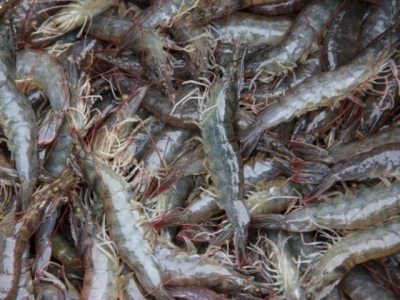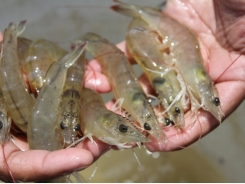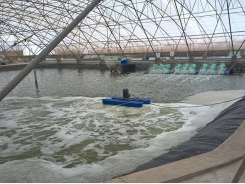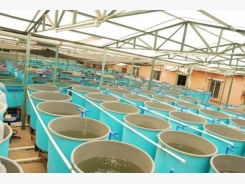Can fermented soybean meal replace fishmeal in shrimp feed?

Fermented soybean meal may offer partial fishmeal replacement for farmed shrimp and support growth, production.
A team of Egyptian researchers explored the use of solid state fermented soybean meal (SSF-SBM) as a potential fishmeal replacement. They looked for the ingredients influence on survival, body weight, weight gain and growth rate.
“The present study was designed to evaluate the effect of substitution of dietary fish meal (FM) with solid state fermented soybean meal (SSF-SBM) by Saccharomyces cerevisiae on growth performance, feed utilization and acceptability of F. indicus,” said the researchers in the report. “Furthermore, nutritional values and economic efficiency of the different diets was also considered.”
The group found that the replacement products could support shrimp production in a cost-effective manner.
“The results indicate that SSF-SBM with yeast, S. cerevisiae, is an acceptable alternative plant protein source that can replace up to 50% of dietary FM protein in diets of Indian white shrimps, F. indicus PL which yields similar growth and production, and is as cost effective, as the control diet,” team members said.
The team said the project was funded by the National Institute of Oceanography and Fisheries (NIOF), Ministry of Scientific Research and Technology, Egypt.
Fermented soybean meal
Feed used in aquaculture is one of the highest reoccurring costs and may account for 30-70% of the variable costs of production, said the researchers.
Additionally, many diets include fish meal (FM) which is putting pressure on formulation overheads, they said. “Increasing FM cost, decreasing availability, irregular supply and poor quality of FM have put forward emphasis on its partial or complete replacement with alternative protein sources (Ramachandran and Ray, 2007),” wrote the authors.
Use of plant proteins would be a more sustainable option, and has been explored for several species, they said.
“Among plant feedstuffs being investigated to replace FM, soybean meal (SBM) is considered a promising protein source because of its stable supply, price and nutritional composition (Lemos et al., 2000),” said the researchers. “Hence, the use of SBM as a dietary protein stuff was studied for many aquaculture species, such as Atlantic salmon, Salmo salar ( Refstie et al., 1998), white shrimp, Penaeus vannamei ( Lim and Dominy, 1990 and Lim and Dominy, 1992), American lobster, Homarus americanus ( Floreto et al., 2000) and Asian sea bass, Lates calcarifer ( Gatlin et al., 2007).”
There are some concerns about using soybean meal including anti-nutritional factors and limited amino acid profile, they said. However, fermenting the bean may improve nutritional factors and digestibility, said the researchers.
Little research has been done on feeding a fermented soybean meal to farmed shrimp, they also noted.
Study details
Commercial soybean meal (CSBM) was purchased from local company and grounded to a particle size. Fermented CSBM was performed by a modification of a method of Yabaya et al. (2009), in triplicate, said the team.
The trial involved giving 225 shrimp one of five trial diets for a period of 90 days.
The diets included a control with fish meal as the main protein source, said the scientists. Experimental diets replaced 25%, 50%, 75% or 100% of the fish meal with solid state fermented soybean meal.
Shrimp weight, length were measured at the start of the experiment and at two week intervals, said the researchers. Weight gain (WG), specific growth rate (SGR), survival rate (SR), the feed conversion ratio (FCR), economical conversion rate (ECR) and protein efficiency ratio (PER) were determined.
At the end of the experiment a selection of shrimp where harvested and checked for ash, crude protein and crude fat levels, they said.
Results
An initial comparison of nutritional factors within the soybean meal and the fermented soybean meal found that the fermented product had more crude protein and crude lipid over time and a lower amount of fiber, said the researchers.
“The crude protein percentage ranged from 44.0 to 50.0 while crude lipid percentages range from 4.3 to 4.8%,” they said. “The total amino acid of SSF-SBM increased by 16.27% compared to CSBM (Table 2). Essential amino acids, including arginine, histidine, lysine, methionine, leucine, isoleucine, threonine, phenylalanine and valine in YFSBM increased by 8.39%, 2.72%, 30.95%, 14%, 30.10%, 4.19%, 2.25%, 4.25% and 11.53%, respectively compared to CSBM [commercial soybean meal].”
Larger amount of SSF-SBM in the diet tended to reduce both final body weight and shrimp growth, said the researchers.
“FBW [final body weight], FBL [final body length], K [potassium], WG, SGR, PER, FI (feed intake) and SR were significantly higher in FS0, FS25 and FS50 when compared to other diet,” they said. “In opposite, FCRs were significantly higher as more FM was replaced.”
The breakpoint was found to be 28.57% of fermented soybean meal allows for improvement in growth performance, they said. And the shrimp with the highest protein content received the FS25 diet.
“The diets containing SSF-SBM are good dietary protein source for F. indicus shrimp postlarvae feed and it can be replaced up to 28.57% with dietary FM which could be consider more economic compared to the diet containing high level of FM protein replacement by SSF-SBM due to lower cost of diets,” they said. “Substitute of higher SSF-SBM proteins in F. indicus shrimp diet may need to fortify complementary protein sources.”
Feed costs reduced linearly as amount of fishmeal in the diet diminished, said the researchers. “The substitution of 50% of dietary FM by SSF-SBM reduced feed costs by 16.51%,” they added.
Related news
Tools

Phối trộn thức ăn chăn nuôi

Pha dung dịch thủy canh

Định mức cho tôm ăn

Phối trộn phân bón NPK

Xác định tỷ lệ tôm sống

Chuyển đổi đơn vị phân bón

Xác định công suất sục khí

Chuyển đổi đơn vị tôm

Tính diện tích nhà kính

Tính thể tích ao




 Torula yeast can replace up to 60% of…
Torula yeast can replace up to 60% of…  What makes feed more appealing for farm-raised shrimp?
What makes feed more appealing for farm-raised shrimp?